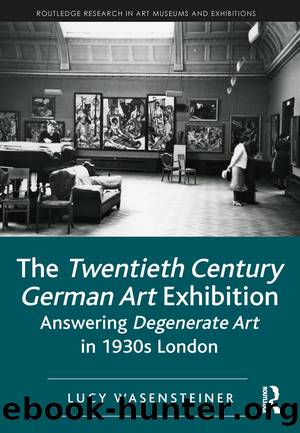The Twentieth Century German Art Exhibition by Lucy Wasensteiner

Author:Lucy Wasensteiner
Language: eng
Format: epub
Publisher: Taylor & Francis (CAM)
4Herbert Read and the Defence of German Modernism
From its opening sentences, Read’s introduction to Modern German Art made clear his view that an educational exhibition of the style was long overdue. According to Read, German modernist art was ‘totally unknown’ in the Britain of 1938: ‘even among those who are particularly concerned with modern art … it is almost entirely neglected’.31 A number of reasons for this neglect were then cited, including the cultural divisions prompted by the First World War. The ultimate cause, however, could be traced back much further, to the centuries-long dominance of ‘Latin standards’ in art, a set of ideals developed from the ‘classical standards of the Mediterranean’. There was, he claimed, an alternative means of appreciating art, more applicable to the art of northern Europe: namely, according to the ‘equal and opposite’ set of aesthetic criteria, ‘belonging to the Gothic North’.32 It was as part of a specifically northern tradition that the art at the New Burlington Galleries should be judged. The anonymous introduction to the Twentieth Century German Art catalogue, covering just two pages, restated these arguments in general terms.
The division Read presented in these texts, between ‘southern-Latin’ and ‘northern-Gothic’ aesthetic standards, can be traced directly to the writings of German cultural theorist Wilhelm Worringer. In his 1906 doctoral thesis, published in 1908 as Abstraktion und Einfühlung (Abstraction and Empathy), Worringer characterised abstract art as flowing from the artist’s psychological unease with the outside world, forcing a retreat from reality, into abstraction.33 Three years later Worringer applied these theories specifically to the stylistic characteristics of Gothic architecture, in the 1911 book Formprobleme der Gotik (Form Problems of the Gothic). Here Worringer identified the Gothic ‘not [as] a phenomenon bound to any single period or style’, but as ‘an ageless racial phenomenon, deeply rooted in the innermost constitution of Northern man … not to be uprooted by the levelling action of the European Renaissance’.34 In texts published over the next decade Worringer explicitly identified the Gothic as a precursor to abstraction, and specifically to Germany’s contemporary expressionist art.35 Expressionism was to be valued as the result of an alternative, northern tradition, derived from artistic introversion, rather than from some striving for universal formal values so often identified in the art of the Mediterranean.
Though somewhat criticised within German academia, Worringer’s theories found a wide readership during the 1910s and 1920s – in particular in Britain, where many were eager to challenge the increasingly dominant formalist ideas of Bloomsbury theorists Clive Bell and Roger Fry, based as they were almost exclusively on ‘southern’, namely French, art.36 British writer T. E. Hulme was a particularly ardent defender of Worringer’s ideas. In 1921 Herbert Read was engaged to edit Hulme’s papers following the latter’s death in the First World War. Here Read came into contact with Worringer for himself, publishing the first English translation of Formprobleme der Gotik, under the title Form in Gothic, in 1927.37 As noted by art historian Christian Weikop, Read’s espousal of Worringer can be
Download
This site does not store any files on its server. We only index and link to content provided by other sites. Please contact the content providers to delete copyright contents if any and email us, we'll remove relevant links or contents immediately.
The Monuments Men by Robert M. Edsel(1485)
Things Are What You Make of Them: Life Advice for Creatives by Adam J. Kurtz(1450)
The Freelance Manifesto: A Field Guide for the Modern Motion Designer by Joey Korenman(1226)
101 Gag Ideas: Companion to the One Minute Caricature by James van der Keyl(1087)
Find Your Artistic Voice by Lisa Congdon(1057)
Boom by Michael Shnayerson(1024)
The Business of Being an Artist by Daniel Grant(973)
Your Art Will Save Your Life by Beth Pickens(949)
The Lady in Gold by Anne-marie O'connor(943)
Your Inner Critic Is a Big Jerk by Danielle Krysa(935)
Create Your Art Career by Rhonda Schaller(931)
Breakfast at Sotheby's(916)
Seven Days in the Art World by Sarah Thornton(914)
How to Survive and Prosper as an Artist by Caroll Michels(865)
33 Artists in 3 Acts by Sarah Thornton(853)
When Talent Isn't Enough: Business Basics for the Creatively Inclined by Kristen Fischer(837)
Art Held Hostage by John Anderson(826)
The Graphic Designer's Guide to Better Business Writing by Barbara Janoff & Ruth Cash-Smith(814)
Art of the Deal by Noah Horowitz(813)
